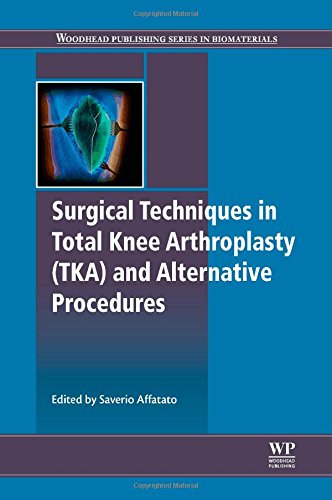(Ebook PDF) Surgical Techniques in Total Knee Arthroplasty and Alternative Procedures 1st Edition by Saverio Affatato ISBN 9781782420385 178242038X full chapters
$50.00 Original price was: $50.00.$35.00Current price is: $35.00.
Surgical Techniques in Total Knee Arthroplasty and Alternative Procedures 1st Edition Saverio Affatato Digital Instant Download
Author(s): Saverio Affatato
ISBN(s): 9781782420309, 1782420304
Edition: 1
File Details: PDF, 30.48 MB
Year: 2014
Language: english
(Ebook PDF) Surgical Techniques in Total Knee Arthroplasty and Alternative Procedures 1st Edition by Saverio Affatato-Ebook PDF Instant Download/Delivery:9781782420385, 178242038X
Instant download Full Chapter of Surgical Techniques in Total Knee Arthroplasty and Alternative Procedures 1st Edition after payment

Product details:
ISBN 10:178242038X
ISBN 13:9781782420385
Author: Saverio Affatato
Total knee arthroplasty (TKA) is commonly considered to be a reliable procedure, with high implant survival rates at 10 to 15 years of follow-up. The goal of total knee replacement surgery is to relieve pain and obtain better knee function. This is achieved by ensuring correct patient selection, pre-operative deformity, implant design and accurate surgical techniques. This book covers a range of techniques for the realisation of functional joint motion and stability. The first part of the book will describe fundamentals in total knee arthroplasty and alternative procedures. The second half will look at surgical techniques and considerations whilst the final chapters will address future trends and challenges in the field of knee surgery. This book will be an essential reference for academics, orthopaedic surgeons, and those training in medicine, physiatry and rheumatology.
Table of Contents:
- Part One: Fundamentals in total knee arthroplasty and alternative procedures
- 1. The history of total knee arthroplasty (TKA)
- Abstract
- 1.1 Knee anatomy
- 1.2 History of total knee arthroplasty (TKA)
- 1.3 Indications for a TKA
- 1.4 Biomaterials used in TKA
- 1.5 Operative procedure for TKA
- 1.6 Surgical techniques
- 1.7 Improvements and modern surgical TKA operations
- 1.8 Alternative techniques to TKA operations
- Acknowledgement
- 2. Biomechanics of the knee
- Abstract
- 2.1 Knee joint anatomy
- 2.2 Analysis of motion
- 2.3 Knee biomechanics
- 2.4 Knee kinematics
- 2.5 Knee statics
- 2.6 Knee dynamics
- 2.7 Biomechanical model of the knee
- 2.8 Kinematics models
- 2.9 Static or nearly static models
- 2.10 Dynamic models
- 2.11 Knee pathologies
- 2.12 Knee prosthesis
- 2.13 Knee biomechanics after knee replacement
- Acknowledgements
- 3. High tibial osteotomy (HTO) surgery
- Abstract
- 3.1 Introduction
- 3.2 Biomechanical principles
- 3.3 Patient selection and preoperative evaluation process
- 3.4 Selection process criteria
- 3.5 Surgical technique
- 3.6 Postoperative complications
- 3.7 Revision surgery for late failure of HTO
- Acknowledgement
- 4. Arthroscopic débridement in total knee arthroplasty (TKA)
- Abstract
- 4.1 Introduction
- 4.2 Intra-articular lesions in knee osteoarthritis
- 4.3 Preoperative considerations
- 4.4 Imaging
- 4.5 Knee osteoarthritis: definition
- 4.6 Historical evolution of arthroscopic débridement
- 4.7 Indications and contraindications of arthroscopic débridement
- 4.8 Operative techniques
- 4.9 Role of arthroscopy as an adjunct to open surgery
- 4.10 Results
- 4.11 Future perspectives
- 4.12 Conclusions
- Part Two: Surgical techniques and considerations for total knee arthroplasty (TKA)
- 5. Challenges in total knee arthroplasty (TKA)
- Abstract
- 5.1 TKA in sequelae of poliomyelitis
- 5.2 TKA after high tibial osteotomy
- 5.3 TKA after varus distal femoral osteotomy
- 5.4 Primary TKA in stiff and ankylosed knees
- 5.5 Primary TKA in knees with bone loss
- 6. Preoperative planning in total knee arthroplasty (TKA)
- Abstract
- 6.1 Introduction
- 6.2 Preoperative evaluation of the patient
- 6.3 Indications and contraindications of TKA
- 6.4 Preoperative radiographic analysis
- 6.5 Planning femoral and tibial cuts
- 6.6 Templating
- 6.7 Preoperative planning based on exam findings
- 6.8 Conclusion
- 7. The first surgical approach for total knee arthroplasty (TKA)
- Abstract
- 7.1 Introduction
- 7.2 Historical notes and medical use
- 7.3 Indications for total knee arthroplasty (TKA)
- 7.4 Standard approaches for primary total knee arthroplasty (TKA)
- 7.5 Pre-operative preparation
- 7.6 The traditional anterior surgical approach
- 7.7 Partial knee replacement
- 7.8 Minimal invasive surgery (MIS)
- 7.9 Computer assisted surgery and custom made knee replacement
- 7.10 Rehabilitation
- Acknowledgement
- 8. Surgical exposure in total knee arthroplasty (TKA)
- Abstract
- 8.1 Surgical exposure in total knee replacement (TKR)
- 8.2 Medial parapatellar approach
- 8.3 Subvastus approach
- 8.4 Midvastus technique
- 8.5 Lateral parapatellar approach
- 9. Ligament balancing techniques in total knee arthroplasty (TKA)
- Abstract
- 9.1 Objectives and implications of ligament balancing
- 9.2 General prosthetic considerations about ligament balancing: wear, loosening and proprioception
- 9.3 Surgical techniques
- 9.4 Management of instability or deformity
- 9.5 Surgical tools for ligament balance assessment
- Acknowledgement
- 10. Correcting varus and valgus knee in total knee arthroplasty (TKA)
- Abstract
- 10.1 Correcting varus knee in TKA
- 10.2 Correcting valgus knee in TKA
- 10.3 Conclusion
- 11. Mini-invasive approach in total knee arthroplasty (TKA)
- Abstract
- 11.1 Introduction
- 11.2 General observations
- 11.3 Limited medial parapatellar arthrotomy (LMPA)
- 11.4 Limited subvastus (LS) approach
- 11.5 Limited midvastus approach
- 11.6 Quadriceps-sparing (QS) approach
- 11.7 Is MIS really MIS?
- 11.8 Conclusion
- Part Three: Future trends and challenges in total knee arthroplasty (TKA)
- 12. Applications of computer-assisted surgery (CAS) in total knee arthroplasty (TKA)
- Abstract
- 12.1 Introduction
- 12.2 Total knee arthroplasty
- 12.3 Unicompartmental knee arthroplasty
- 12.4 Revision total knee arthroplasty
- 12.5 Knee ligament reconstruction
- 12.6 Osteochondral lesion
- 12.7 High tibial osteotomy
- 13. Patient-specific instrumentation (PSI) in total knee arthroplasty (TKA)
- Abstract
- 13.1 Introduction
- 13.2 Patient-specific instrumentation – the impetus for its development
- 13.3 Using patient-specific instrumentation: from the office to the operating room
- 13.4 Patient-specific instrumentation – a review of the current literature
- 13.5 Future directions
- 14. Revision total knee arthroplasty (TKA)
- Abstract
- 14.1 Introduction
- 14.2 Indications for revision
- 14.3 Preoperative assessment
- 14.4 Approach and skin incision
- 14.5 Removal of the components
- 14.6 Three step technique
- 14.7 Postoperative rehabilitation
- 14.8 Conclusion
- 15. Diagnosis and management of infection in total knee arthroplasty (TKA)
- Abstract
- 15.1 Introduction and pathogenesis
- 15.2 Risk factors and clinical evaluation
- 15.3 Diagnosis
- 15.4 Treatment options
- 15.5 Conclusions
People also search:
surgical techniques in total knee arthroplasty and alternative procedures
surgical techniques and instrumentation in total knee arthroplasty
surgical technique for total knee replacement
types of total knee arthroplasty
total knee replacement surgical technique and instrumentation
Tags:
Surgical Techniques,Total Knee Arthroplasty,Alternative Procedures,Saverio Affatato


